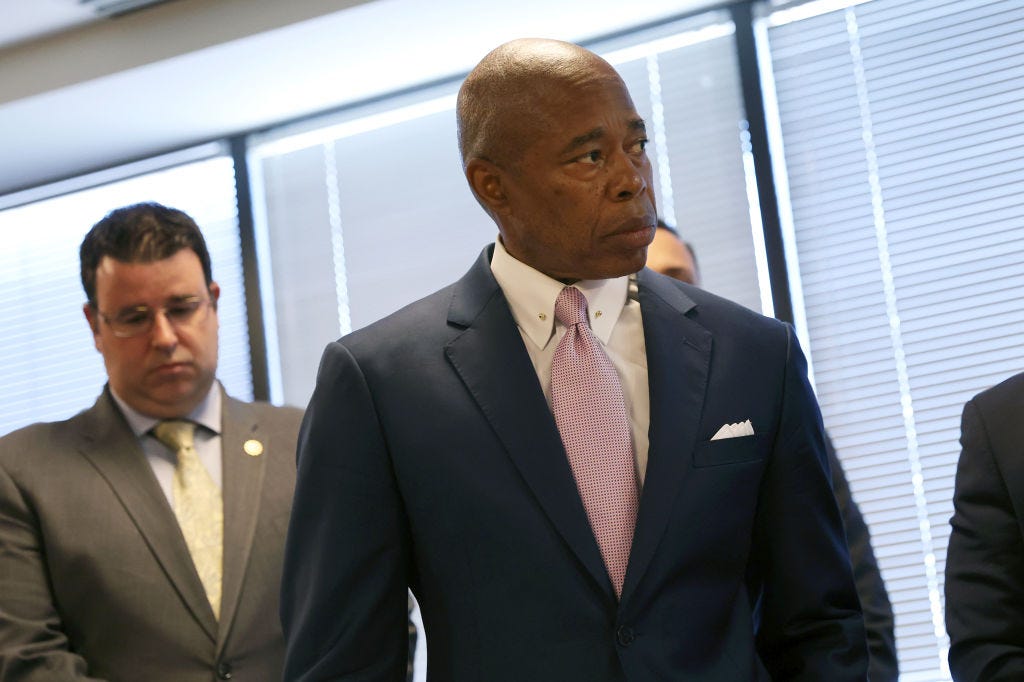Eric Adams Gets His Rent Increase
The Rent Guidelines Board is done bailing out renters
In the end, Eric Adams got what he wanted.
On Tuesday night, the Rent Guidelines Board voted to raise one-year leases by 3.25% and two-year leases by 5% on rent-stabilized tenants. It was the culmination of a year-long process that Adams had always signaled would only go one way if he managed to become mayor of New York City. With rents skyrocketing to levels never before seen in modern times, Adams offered little hope for the more than one million tenants in New York City who are lucky enough to live in rent-stabilized apartments. The increases they will face are not nearly what renters in the frenzied open market must contend with, but they will pave the way for future hikes. Landlords, who have Adams’ ear, will be back for more next year.
This is Adams at his essence. His mayoralty has largely been unfocused, with few signature policies to capture the public imagination. His approval ratings are low and he is failing, inevitably, to rapidly lower the city’s crime rate. This is not entirely his fault—no single executive can control how high or low crime goes—but it’s the standard by which he’s decided to be judged. He won a Democratic primary promising, as a former police captain, to bring law-and-order to City Hall. More quietly, he promised the real estate elites that run New York he would be a friend to them, happily taking their campaign cash. Unlike Bill de Blasio, his predecessor, Adams wouldn’t feel terribly motivated to aid working-class tenants, even when they voted for him. The era of rent freezes would end.
“Small landlords are at risk of bankruptcy because of years of no increases at all, putting building owners of modest means at risk while threatening the quality of life for tenants who deserve to live in well-maintained, modern buildings,” Adams said in a statement after the vote. Never mind that the average apartment in New York City belongs to a 21-property, 893-unit portfolio, according to a 2020 analysis.
The argument for the rent increases—from Adams, the Real Estate Board of New York, and critics of rent-stabilization—is that inflation made them necessary. And it’s true that landlords must contend with rising fuel and labor costs. Tenants, of course, are facing down cost-of-living expenses just as directly. And unlike landlords, they have no equity to fall back on, no lucrative investment to borrow against or sell for a profit. The average landlord is deeply wealthy compared to the average tenant because real estate in New York is such a valuable asset, especially now. In the last half century, there’s rarely been a poor moment to invest in property.
A sizable number of landlords wanted much larger rent increases. Seven, eight, nine percent. Higher. There is anger from the Covid era and the eight years de Blasio was mayor. De Blasio froze rents on rent-stabilized apartments multiple times. An eviction moratorium kept landlords from evicting tenants for two years. There is a sense, among this privileged class, that whatever they were making was not simply enough. When inflation was virtually nonexistent, Bloomberg’s Rent Guidelines Board hiked rents much more than the board did last night. Since Adams has the power to appoint all nine members, we will likely see a return to that sort of calculus. The 3.25% and 5% are down payments on the future. Expect more of the same next year.
While de Blasio was plenty friendly to developers and landlords, he understood New York tenants were far less powerful, forever at the mercy of unfriendly market forces. Rent-stabilization is a gift, but not a radical one. Rent-stabilized apartments can be quite expensive. Hundreds of thousands of them disappeared altogether from the late 1990s until 2019, when state law allowed landlords to take stabilized apartments out of the program when their rents surpassed a certain threshold. A tenant in a rent-stabilized apartment has the right of their rent to be set by the Rent Guidelines Board—still a blessing compared to the current market—and the ability to renew a lease. Capricious evictions are far less likely to happen if you manage to secure a rent-stabilized apartment. In an ideal world, state government would be expanding these protections to everyone.
Others answers to the housing crisis are needed, too. NIMBY’s must get out of the way and let the city build. New York, thankfully, is not California and can’t afford to strangle housing construction in such a way. Housing supply must increase. It’s important for the city, state, and federal governments to get much more directly involved in subsidizing affordable housing, creating land trusts and land banks, and aggressively converting under-utilized hotels into conventional housing and SRO’s. A return to the New Deal era of federal investment in public housing would be ideal, if unlikely. Adams’ own housing vision, unsurprisingly, remains piecemeal and lacks ambition. We can only hope that will change.



- defunded public schools by the highest cut since the great recession
- raised rents on stabilized apts by the highest level since bloomberg
- increased the police budget to its highest level ever
we are so %*@!. Despite flaws, we will miss DiBlasio.